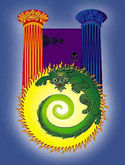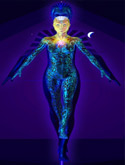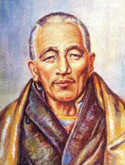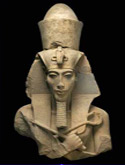Socrates—Greek Philosopher, Teacher of Plato
May 20, 467 BC, birth place unknown, but proposed as Athens. There is insufficient data given to do anything but cast a chart for around noon. (Source: Maurice Wemyss who references the ancient records that Socrates was born on the 6th Thargelion in the 4th year of the 77th Olympiad—according to Stanley’s History of Philosophy, equated with May 20, 467 BC O.S.). Using approximately that time, the Ascendant could be either late Leo or early Virgo; MC, either Taurus or Gemini; Sun conjunct Jupiter in Taurus with both near the MC; Venus, retrograde, conjunct Mercury in Gemini; Mars in Aries; Saturn in Leo; Uranus in Virgo rising close to Ascendant; Neptune in Capricorn; Pluto in Scorpio near the IC).

 There are good reasons for thinking that either a Leo or Virgo Ascendant is justified. If Virgo, however, it is unlikely that the birth would be any later the 12:33 PM, LMT, due to the manner of Socrates’ historically renowned death—he was made to drink the poison, Hemlock, which would fit well with Pisces (ruled by drug-related Neptune and deadly Pluto—the orthodox Jupiter rulership of Pisces, with Jupiter on or near the MC relating to the fact that his is one of the most significant and inspiring deaths in all history). On the other hand, and improbably, the Aries eighth house cusp would relate to a sudden, violent death—especially since Mars in natally placed in Aries—a death very unrelated to death by relatively painless poison… It is also unlikely that the birth occurred before 11:50 AM, LMT, as a birth prior to this time would remove the Sun from the ninth house of philosophy, and emphasize instead a more public career or office. Socrates is thought by many to have neglected his civic duties, since, though qualified, he never sought public office, and, instead, used every occasion to discuss issues of philosophy whenever and wherever his fellow citizens congregated.
There are good reasons for thinking that either a Leo or Virgo Ascendant is justified. If Virgo, however, it is unlikely that the birth would be any later the 12:33 PM, LMT, due to the manner of Socrates’ historically renowned death—he was made to drink the poison, Hemlock, which would fit well with Pisces (ruled by drug-related Neptune and deadly Pluto—the orthodox Jupiter rulership of Pisces, with Jupiter on or near the MC relating to the fact that his is one of the most significant and inspiring deaths in all history). On the other hand, and improbably, the Aries eighth house cusp would relate to a sudden, violent death—especially since Mars in natally placed in Aries—a death very unrelated to death by relatively painless poison… It is also unlikely that the birth occurred before 11:50 AM, LMT, as a birth prior to this time would remove the Sun from the ninth house of philosophy, and emphasize instead a more public career or office. Socrates is thought by many to have neglected his civic duties, since, though qualified, he never sought public office, and, instead, used every occasion to discuss issues of philosophy whenever and wherever his fellow citizens congregated.
Socrates was one of the greatest of all philosophers and a modern man in many respects. He could be regarded as the ‘Father of Western Philosophy’, and was, according to Plato in his Apology, pronounced by the Oracle of Delphi to be the wisest man in all Greece, even before his fortieth year.
The “Acute Energy of Divine Mental Perception”, the energy of the third ray, was fully manifest through Socrates, as was the power to illumine conferred by Taurus. As well, because he was a great teacher to many (and especially to Plato, found according to the Tibetan upon the second ray) and a lover of wisdom (which is what the word “philosophy”—philo sophia—means) his relation to the second ray of Love-Wisdom (and especially to wisdom) is more than reasonable.
“Such Avatars were Plato, the first Patanjali and Sankaracharya; they emerge upon the second ray line of energy, in the department of the Christ and are expressions of hierarchical force.” (EXH 298)
As Socrates was a major “light bearer” intimately related to the world of “ideas” or “forms” (as Plato called his archetypes), his major rays may be presumed to be similar to those of Plato—namely the second and the third.
Because his philosophical method was critical, sharp, logical, syllogistic and endlessly inquisitive, there is evidence for the presence of the fifth ray in the mind, but Mercury in oscillatory Gemini would surely provide ample fourth ray facility—he was always in discussion and dialogue. His mind was unclouded by emotion (as his serene and noble behavior through his death process clearly indicates). This may speak of the second ray in the emotional nature. Perhaps not much can be said of his physical nature (other than to cite his proverbial ‘ugliness’ or crudeness of form, and to infer that he was physically strong, as stories of his courage in war suggest). He did not seem to be a person of regular habits (seven ray, in the physical nature) but rather a peripatetic—always walking and talking his great love, philosophy. This seems more related to the third ray in the outer, physical-etheric nature.
Socrates’ major precept was “know thyself”. This illuminating dictum has resounded resonantly down the ages as the keynote of Socratic philosophy. All students of esoteric astrology recognize the relation of this injunction to the sign, Leo, the sign of self-knowledge. It is no wonder that the Oracle of Delphi considered him the wisest of men, for “know thyself” was the keynote of the Oracle as well.
Socrates (though some dispute his actual physical existence, just as some dispute the actuality of Jesus) was a great light, and yet a humble person. In all humility (not just a Virgoan trait, but one achieved by the advanced Leo individual) he wondered in puzzlement why the Oracle had declared him the wisest, but then concluded (a little humorously yet aptly) that, while others professed knowledge without realizing their ignorance, he at least was aware of his own ignorance. The issues of pride and humility (especially, when the third ray is involved—mental pride and humility) is pivotal to the Leo experience of the initiate (and certainly Socrates was an initiate of some degree, perhaps the third).
We must also remember the two keynotes of Leo—the “Will to Rule” and the “Will to Illumine”. It is the latter to which Socrates, obviously, related. Perhaps his connection to the first keynote manifested in his determination to master or rule over ignorance. His position with respect to ignorance was very much like that of the Buddha, Who considered ignorance the greatest sin. For Socrates, virtue and knowledge were identical; thus, no person (who knew better) would willingly do the wrong. Is this an optimistic second ray attitude, finding, through overestimation, too much “good” in human nature? According to the Tibetan, the second ray type often has this attitude towards “loved ones”. Socrates held it for all human beings.
A few other characteristics point to the reasonableness of Leo as an Ascendant. Socrates was, reputedly, a man of great physical courage, who fought nobly and powerfully in war. With a late Leo Ascendant, the zodiacal decanate ruler would be Aries, with its ruler Mars already placed in courageous Aries; Mars would trine a late Leo Ascendant. (Of course, Jupiter as the ruler of the third decanate of Leo—as proposed by the Tibetan—would contribute to the quality and scope of the illuminative power which Socrates carried.)
As well, Socrates did more than just talk—although he did that quite well, with his Mercury and Venus conjunction in Gemini. He lived his convictions. There were probably ways in which he could have avoided his death sentence for religious heresy (Uranus rising, Sun in ninth house), and corrupting Athenian youth (Neptune in the fifth house), but, instead, he accepted the judgment with great serenity, humility and courage, and set an historically inspiring example of the philosophical and noble death. To the author’s judgment, this relates more to the sign Leo (the sign of “coeur-age”) than to Virgo (though, significantly, the veiled hierarchical ruler of Leo, Uranus, is placed in Virgo and is rising).
The sculpted images we have of Socrates also suggest the more hearty and vigorous Leo rather than the Virgo of slighter frame. As well, were Virgo the Ascendant, the ruling planet, Mercury, for which sign placement is so physiognomically and physically revealing when one of the Mercurial signs (Gemini or Virgo) is the Sun or Ascendant, would be placed in Gemini (another sign giving height, slenderness and spareness). The image of Socrates much more suggests his Taurus Sun, which would be physiognomically accented were Leo (ruled by the Sun) the Ascendant. Socrates’ reputed strength and fortitude in battle also suggest Leo. The Moon would be in Cancer in any case, and is surely reflected physiognomically in the images of him which claim to represent him.
One other interesting matter is of moment. Socrates would, legend tells, suddenly become wrapped in deep communion with his “Daimon”—his “Inner Genius” or “Inner God”. He is reputed to have stood still for three whole days in deep meditative process with this “god”, whom esotericists will recognize as the soul or Solar Angel. Apart from the tremendous fortitude and fixity (Leo and Taurus) required for such a physical feat (if the story is true, he certainly did not observe seventh ray rhythms), the “Daimon”, or Solar Angel, is directly connected with the solar sign, Leo. This Solar Angel is a far higher form of identity than the customary ego or personality, and Socrates, so it seems, was deeply impressed by the need to understand the scope and nature of identity.
Virgo, as an Ascendant, is not without its justifications. The keen mental discrimination of Virgo would be strongly in evidence, along with the Virgoan traits of modesty, piety and humility, and critique (he was the “gad-fly”—often more than unappreciated—to Athenian society). Socrates was, we know, deeply interested in ethics—a sometime Virgo preoccupation. With a Virgo Ascendant, his Mercurial characteristics (already very powerful through the Mercury/Venus conjunction in Mercurial Gemini) would be even more strongly accented.
We must ask whether the Venus/Mercury conjunction (both orthodox and esoteric ruler of Gemini in Gemini) plus a strong fifth ray, would be sufficient to give him his critical (and ironic) method of inquiry. Very possibly. Mental, revolutionary Uranus (veiled hierarchical ruler of Leo) also cannot be ignored in Socrates’ case, as he may well have been an illumined initiate of the third degree; certainly his survival as a great philosophical influence warrants that he was no ordinary individual, and possessed an encompassing mountain-top perspective (though he surely would have denied it). In a way, Socrates was responsible for a philosophical revolution (at least in terms of technique—Virgo). He emphasized the method of the “dialectic” a logical method which consisted in examining statements by pursuing their implications, on the assumption that if a statement were true it could not lead to false consequences. This approach was intellectually revolutionary for his time. Socrates’ contributions to philosophy were a new method of approaching knowledge, a conception of the soul as the seat both of normal waking consciousness and of moral character, and a sense of the universe as purposively mind-ordered. Interestingly, Einstein, another mental revolutionary, had a prominent Uranus in Virgo.
Tradition has it that Socrates not only neglected his civic and social ‘duties” (though not his military duties—Mars in Aries) in favor of philosophical discussion, but his home duties as well. His wife, Xanthippe, has become legendary as a shrew. Perhaps it is no easy thing to be married to a philosopher! One wonders if, with a Virgo Ascendant, Socrates might have paid a bit more attention to his domestic responsibilities (he already had the Moon in Cancer, tying him, at least unconsciously, to the “Mother Force”). Rather, it would seem, he exemplified a Leo Ascendant (following his individual and deeper soul calling, ignoring the more mundane considerations to which Virgo would have related him). If this interpretation has merit, his Virgoan expression related more to innovations (Uranus) of new philosophical techniques (Virgo) and these he carefully cultivated (Virgo).
The power for philosophy of a conjunction between the radiant Sun and philosophical, second-ray Jupiter in luminous Taurus, with the Sun in the house of higher mind (the ninth) and Jupiter just into the tenth (reputation and vocation) speaks for itself. Socrates’ mind was ever dwelling upon the ;great thoughts, though his Geminian intellect (fourth ray Mercury and fifth ray Venus, retrograde, in second ray Gemini) gave him the versatility and adaptability to be intellectually sharp on the level of concrete mind as well. Dedicated Vesta, conjunct first Venus and then, by translation of light, Mercury, adds great focus to the intellectual, Geminian preoccupation. The Sun and Jupiter (both of them on the second ray) are (using this approximate chart) either conjunct or very close to the MC. Thus the light which Socrates’ stimulated has already lasted nearly 2500 years. The MC in Taurus seems correct, rather than in more versatile, mobile, Gemini, for Socrates, like the Taurean Buddha, was a great light-bearer and light-bestower.
A few declinations are interesting and important. Venus and Mercury (already powerful by longitudinal conjunction) are closely parallel in the same degree of declination, adding to Socrates’ versatile, mental brilliance. Saturn and Moon, only very widely conjunct by longitude, are parallel within twenty minutes of arc by declination, giving him his ‘home karma’ (his challenges and domestic sorrows, even as he shone brilliantly among his philosophical colleagues and the social elite), and also, the later rejection by the state of Athens (Saturn representing the law and the Moon, one’s community). Socrates’ intellectually nonconformist nature is accented by the close parallel between revolutionary Uranus, assertive Mars and ingenious Pallas Athene; clearly, he went his own way and broke through traditional boundaries of thought (Mars/Uranus), even in that relatively free-minded society.
A few stars tell a supportive story. Mars (battles and initiatives in the ninth house of philosophy—part of the “gadfly” character theme) is parallel one of the stars in the constellation Aries—Hamal, which means, “to go one’s own way”. Mars is also conjunct Mirfak which is interpreted as “challenge-oriented”. With an Ascendant in the last degree of Leo, both Betelgeuse (“uninterrupted success”) and Polaris (the power to “show the way” or direct) would, significantly, be on the MC.
The position of Pluto cannot be ignored as a the planet of death (and esoteric ruler of the house of death—the eighth, placed, as well, in Scorpio, the sign of death). Pluto is positioned in the house of the home or “city state” (Athens), quite closely conjuncted to the IC. Exoterically, Pluto may have contributed to his unhappy home life; perhaps he was thrown out of the house (exiled) more than once. He was also rejected and, even, killed by those in authority in Athens. The charges against him were unfair, politically motivated, of murky origin and surrounded by obscurity. Clearly, under-handed, ‘subterranean’ forces were at work, and the result was the imposed yet sacrificial death of a great exponent of the Light. Pluto is, characteristically (and significantly), the planet of poison. As well, from an esoteric perspective, the death was a service to the Ashram (fourth house), and served as a model of exemplary, philosophical serenity for two millennia and more. This Pluto (darkness) opposes the brilliant, revelatory, Sun/Jupiter conjunction. This can easily be seen as the inevitable opposition of darkness to the Light of Wisdom. Interestingly, the star, Diadem (“to sacrifice oneself”), is conjunct the rising Uranus, which, itself, is closely parallel to Hamal (again—“to go one’s own way”).
Socrates became convinced that his calling was to search for wisdom (Leo, Taurus, and the second ray) concerning right conduct (Earth signs) by which he might guide the intellectual and moral improvement of the Athenians (transformative Uranus in improvement-oriented Virgo). He made many enemies in the process (unforgiving Saturn in Leo, the sign of pride, in the twelfth house of “hidden enemies”). Their conspiracy against his person, only fanned the flames of the great philosophical quest. We might say that Socrates was a martyr for the spirit of philosophy, though there was in his martyrdom none of the fanatical sixth ray.
As a synthetic thinker, Socrates displayed the union of the second and third rays, as did Plato. Perhaps the monad was upon the third, the soul upon the second and the personality upon the third. According to the Tibetan,
“Plato endeavoured to picture forth the completeness of the Whole and the intricacy of the ideas which have come forth as an expression of that Whole.” (EP II 399)
Here we have an example of entirety (second ray) and intricacy (third ray). It is likely that Plato gathered much of his original inspiration from Socrates, who, reasonably, shared the same soul and monadic rays, but with very different personality equipment.
Constellationally, the third ray would have its entry points into the chart through the Cancerian Moon and the Capricornian Neptune. As well, the conjunction of sometime third ray Mercury and luminous Venus in the third sign, Gemini, gives another important conduit for this acutely mental force. The second ray also can enter through the Gemini conjunction, as Gemini (during this world period) is primarily a second ray sign, and Venus (orthodox ruler of his Taurus Sun) has a strong second ray component. The conjunction between the second ray Sun and second ray Jupiter in the second sign, Taurus, gives a potent entry point for the ray of Love-Wisdom—especially, wisdom. Through this conjunction the “Greatest Light” associated with the second ray is accessible.
Neptune would be an esoteric veiled esoteric ruler whether the Ascendant were Leo or Virgo. It is an intuitive planet (with much second and sixth ray) and it is placed in the Leo house (the fifth) in either case. Esoterically, this has to do with inspired creative expression drawing from the realm of accumulated quality—the casual body. What this position says about Socrates’ children (if he had any) or his early artistic life (apparently he practiced the art of his father, Sophroniscus, who was a sculptor) we cannot say. Buddhic Neptune was trine the atmic/manasic planet, Uranus, showing a balance between these factors within the Spiritual Triad. Socrates’ communion with his “Daimon” might also be, in part, reflected here, as Neptune gives impressionability in a field or house (the fifth) where the Solar Angel is strong.
First ray factors are also to be acknowledged, with sometime first ray Uranus rising, and first ray Pluto, angular. If Leo is hypothesized as the Ascendant, then all first ray signs are tenanted, with Mars in Aries being very strong. These factors would strengthen Socrates’ ability to stand on principle, and give his life for his philosophical conviction.
The synthesis of Socrates’ principal third and second rays are reflected in his doctrine of the central importance of the soul leading him to the belief that all virtues converge into one, which is “the Good”, or knowledge of one’s true self and purposes through the course of a lifetime. Knowledge in turn depends on the nature or essence of things as they really are, for the underlying “forms” or archetypes of things are more real than their experienced exemplifications (clearly a second ray perspective) This conception leads to a teleological view of the world that all the forms participate in and lead to the highest “form”—the “form” or archetype of “the Good”. Here we see synthesized the “Greatest Light” and the Wisdom of the second ray and Taurus, as well the brilliant unity-in-light of Leo—the “light of the soul”. (EA 293, 329)
It is unlikely that we will every be entirely certain of the chart of Socrates, or even, in every particular, of his rays, but enough has been suggested to bring forward the major energy pattern of this seminal, revolutionary thinker who, certainly in death, proved himself to be a noble example of his highest thought.














